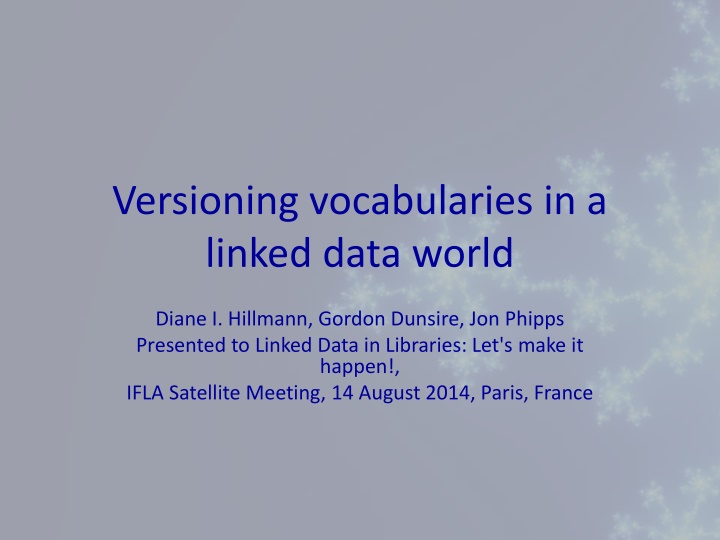
Versioning Vocabularies in a Linked Data World Overview
Explore the concepts of versioning vocabularies in a linked data world, including semantic versions, synchronization, and semantic versioning practices. Discover the importance of maintaining older versions, maintaining local order in global data, and using distributed version control in a smart semantic cloud environment. Learn about the significance of semantic breakage between major versions and providing backwards compatibility in applications.
Download Presentation

Please find below an Image/Link to download the presentation.
The content on the website is provided AS IS for your information and personal use only. It may not be sold, licensed, or shared on other websites without obtaining consent from the author. If you encounter any issues during the download, it is possible that the publisher has removed the file from their server.
You are allowed to download the files provided on this website for personal or commercial use, subject to the condition that they are used lawfully. All files are the property of their respective owners.
The content on the website is provided AS IS for your information and personal use only. It may not be sold, licensed, or shared on other websites without obtaining consent from the author.
E N D
Presentation Transcript
Versioning vocabularies in a linked data world Diane I. Hillmann, Gordon Dunsire, Jon Phipps Presented to Linked Data in Libraries: Let's make it happen!, IFLA Satellite Meeting, 14 August 2014, Paris, France
Overview 30 mins It s about time
Linked Data (RDF) Vocabularies Element sets Value vocabularies Datasets
Synchronization? What version?
Semantic versions: the other case Value vocabulary: Things Label Definition Time A A thing that is old. B A thing that is borrowed. C A thing that is blue. A thing that is not an A, a B, or a C. Other Version 1 D A thing that is new. Version 2 Other A thing that is not an A, a B, a C, or a D. Version 1 and Version 2 have different meanings Version 1 and 2 datasets have different semantics Applications have inconsistent or incoherent results
http://dewey.info/class/641/2009/08/about.fr.rdf Many versions of version control! Dated URI Access to old versions? Last date only Fine granularity at transaction level No demand for version aggregation Dated release number Lack of change data
Semantic versioning (semver.org/) 3-tier numbering system: major.minor.patch X X X . . Major: breaks backwards semantic compatibility Minor: change in semantics of any property of any element Patch: no change in semantics of any element
Local applications; global data Maintaining local order in global chaos
Smart semantic clouds Smooth interaction between app and vocab Transparent to the user crowd Until major change requires validation of context Distributed version control (Git, etc.) Vocabulary managers trusted to comply with (simple) semantic versioning And encouraged to provide details of semantic breakage between major versions App developers encouraged to provide backwards compatibility with version ranges
Concluding questions What conditions categorize major/minor semantic changes? Can dataset semantics be versioned? Beyond data dumps Inherited element set and value vocabulary versions? Impact of syntactic or structural breakage? E.g. change from RDFS to OWL versions of an element set Is it time to get serious about linked data management?
Thank you! Linking Open Data cloud diagram, by Richard Cyganiak and Anja Jentzsch. http://lod- cloud.net/ Flammarion engraving: artist unknown We are here
